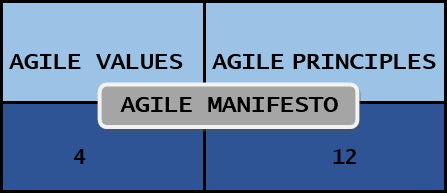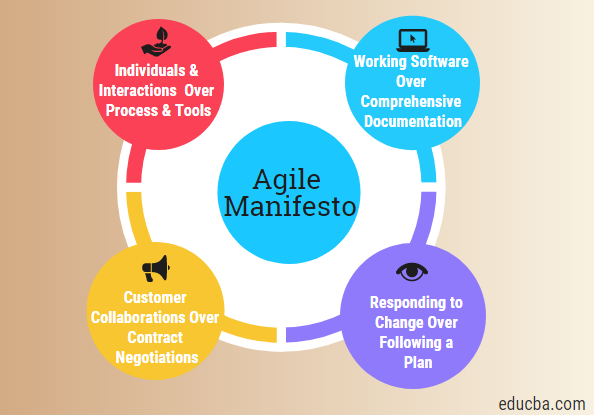Overview of Agile Values And Principles
This article provides an outline of the most commonly used values and principles in Agile. No wonder ‘Agile’ has offered an effective replacement to the conventional waterfall model of project management. Due to the cumbersome, rigidly slow, and document-centric method of product development, the team of 17 system developers (called the ‘Agile Alliance’) came out with an ‘Agile Manifesto’ in the year 2001.
Agile Manifesto has garnered global acceptance and can be defined as a documented set of 4 values and 12 principles which offer guidelines to the developers for system/application development.
Thus, the Agile Manifesto contains ‘4 key values’ and ’12 corresponding principles’ that direct the agile methodology for system development. The Agile Manifesto serves as the guiding manual to deliver superior quality products to clients.
Values of Agile Manifesto
Agile Manifesto is comprised of 4 values. Let us understand in detail.
Value #1 – (Individuals and Interactions Matter more than Processes and Tools)
People are the key drivers in bringing about substantial business developments and understanding the client requirements. Developing good products requires effective teamwork and interactions, irrespective of the tools provided to the individuals.
It is not possible to develop great products without understanding the requirement of the clients. Hence, individual interactions help create customer-specific products. Just relying on the processes and tools not only makes the businesses sluggish and irresponsive to changes but also results in failure to meet customer expectations.
Value #2 – (Working Software Matters Over Detailed Documentation)
During the initial times, a huge amount of time was spent on documentation which would include technical detailing and specifications. This exhaustive and rigid method of carrying out document-specific instructions led to project delays and slower product deliveries. Ultimately, the end product would not match the client’s expectations or would become outdated.
With the introduction of Agile, the emphasis shifted to working software from document-guided workflow. Working software-enabled effective adaptability to change and a better understanding of customer requirements. Thus, Agile only limits the use of documents to ‘user stories’, which defines the developers on tasks to be carried out.
Value #3 – (Customer Partnership matters more than Contractual Negotiations)
In the traditional Waterfall model, customers communicate with developers about specific requirements before the project work resumes. The conventional contractual discussion methods create a wall between the customers and developers. Customer involvement is limited to the start of the project and when the product is ready for delivery. And customer participation does not take place during the making process.
Conversely, going by the Agile Values And Principles manifesto, customer participation is encouraged throughout the making or creating process. The agile approach increases customer participation at regular intervals for timely demos. This not only helps to understand the customer requirements but also allows them to deliver value. Thus, collaborating with the customers throughout the entire product life-cycle forms the basis of the Agile Approach.
Value #4 – (Being Adaptive to Change Instead by being Plan-Specific)
Considering the volatile business environment, technological advancements take place, and the needs of the customer change. In traditional waterfall management, change is considered as a cost and is supposed to be avoided. Also, conventional project management is rigid and has less scope of malleability. This inhibits adaptability to change, and as time passes, the plan becomes redundant.
However, Agile considers change as a valuable agent and offers effective responsiveness and adaptability to it. The Agile approach, which consists of shorter iterations and sprints, enables one to add new attributes to the product in consecutive iterations at periodic intervals.
Principles of Agile Manifesto
12 Principles of Agile as Propagated by Agile Alliance are:
1. One of the top priorities of the Agile approach is to aim for customer satisfaction through prompt and continual delivery of value-added products.
2. The agile approach has to embrace changes, even at later stages of development. Change is considered as a valuable agent offering a competitive edge to the customers.
3. Working software should be delivered to the customers for any feedback or suggestions at a periodic interval of weeks or months, preferably in shorter time spans.
4. The business management and system developers should work collaboratively throughout the project cycle.
5. The agile approach believes in assigning projects to motivated individuals and provide the individuals with a good working environment and support system by inculcating trust in them to get the work done.
6. Agile Values And Principles are about fostering face-to-face discussions and promoting them as an effective means of communication to and within the team of developers.
7. Working software is one of the primary means of measuring system progress in agile.
8. The agile approach aims at facilitating consistent and sustainable progress in system development. The stakeholders are required to maintain steady and continual velocity in product development.
9. Staying updated by bringing in continual technological up-gradation and efficiency facilitates the agile approach.
10. The agile process is about adopting simplicity by reducing comprehensive tasks and focusing on the tasks that essentially add value.
11. Self-organized teams help in bringing good structures, requirements, and developments. The agile teams are proactive, which enables them to overcome any hurdles and minimize errors to deliver excellence.
12. Agile teams continually upgrade themselves and aim to become more productive by adapting to changes effectively. The development teams constantly mold and are at peace with the changing external conditions. It enables continual improvisation to deliver value. Periodic feedback from the customers enables the development team to attain it.
Conclusion
Having discussed the 4 values and 12 principles of the Agile Manifesto, it is quite evident that focus on customer gratification has garnered success for agile businesses across the globe. The Agile approach has practically proven to be effective, not limiting to the software industry but across many different industries.
Thus, by abiding by the values and principles of the Agile Manifesto, businesses can garner many benefits, not only just by enhancing productivity and customer satisfaction. But also by staying profitable in the long run irrespective of the external factors.
So, it’s time to change the value system of your businesses and inculcate the principles of the manifesto to bring in an agile culture. Make your businesses Agile-public!
Recommended Articles
This has been a guide to Agile Values and Principles. Here we discussed the Overview, Different values, and principles in Agile. You can also go through our other suggested articles to learn more –




